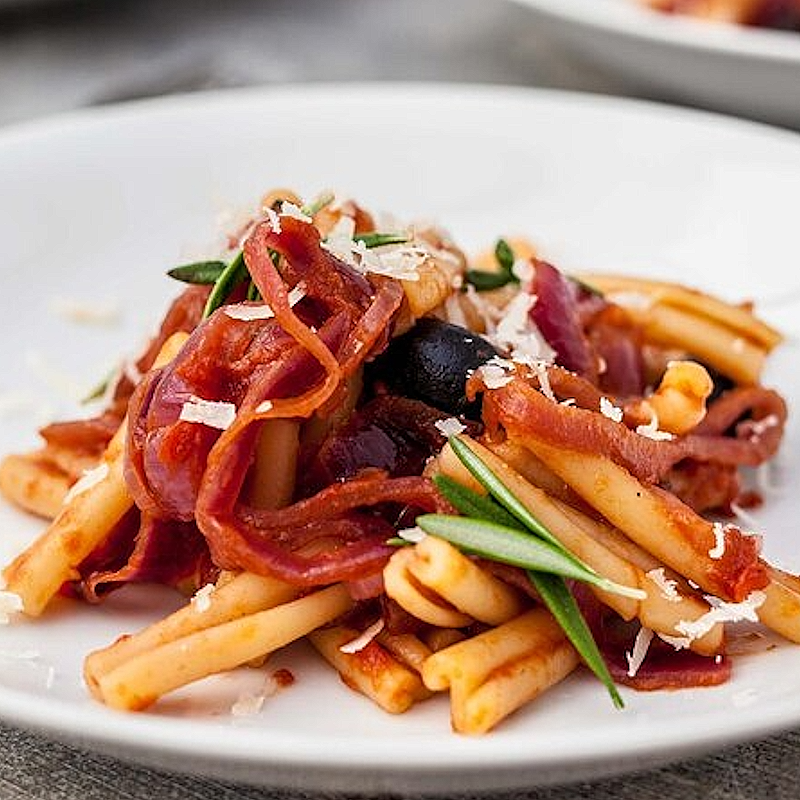Maccheroni alla Napoletana (Francesco Leonardi, 1790)
Francesco Leonardi, a famous Italian chef and cookbook author, is known for his work "L'Apicio Moderno", published in 1790. This book marked a turning point in Italian cuisine and features numerous influential recipes. Although Leonardi is not as well-known as other Italian chefs, his contributions had a significant impact on the cuisine of his time, particularly regarding the evolution of modern Italian cooking.
Here are some iconic dishes from Francesco Leonardi featured in his book:
-
Maccheroni alla bolognese (or alla napoletana): Although ragù bolognese is more famous today for its official recipe, Francesco Leonardi mentions versions of meat-based sauces in his book, which undoubtedly contributed to the development of the modern bolognese.
-
Risotto alla milanese: This dish, already known before Leonardi, is mentioned in his work. Leonardi emphasizes the importance of saffron in this recipe, a distinctive touch of Milanese risotto.
-
Torta di riso: A type of rice cake, typical of the Emilia-Romagna region, which Leonardi describes in his work. Rice was often used in Italian cuisine at the time, including in desserts.
-
Sformato (or savory flan): A type of flan usually made with vegetables, eggs, and cheese. This dish is a light gratin that anticipates modern dishes like soufflés or vegetable gratins.
-
Zuppa di pesce (fish soup): Francesco Leonardi offers various versions of fish soups, which were common in coastal Italian cuisine and reflect the influence of Mediterranean cooking.
In summary, Francesco Leonardi's dishes are a blend of ancient traditions and new techniques that influenced modern Italian cuisine. Many of his recipes highlight the use of fresh local ingredients and simple yet refined cooking techniques that are still appreciated today.
 Garanties sécurité
Garanties sécurité
(à modifier dans le module "Réassurance")
 Politique de livraison
Politique de livraison
(à modifier dans le module "Réassurance")
 Politique retours
Politique retours
(à modifier dans le module "Réassurance")
Maccheroni alla Napoletana (Francesco Leonardi, 1790)
The recipe for Maccheroni alla Napolitena, documented in L'Apicio Moderno by Francesco Leonardi in 1790, marks an important step in the evolution of ragù towards what we now call Bolognese sauce. This recipe introduces tomatoes for the first time, signifying a key transition in Italian cuisine.
Maccheroni alla Napolitena Recipe (Historical Version)
Ingredients:
- Meat: Veal or beef (cut into chunks or small fillets).
- Tomatoes: Either pureed or chopped (approximately 400 g, adjusted according to quantity).
- Pancetta or bacon: 50 g, finely chopped.
- Onion: 1 large, finely chopped.
- Herbs: Basil, parsley, bay leaves (to taste).
- Olive oil or butter: 3 tablespoons.
- Broth: 500 ml (meat or vegetable broth).
- Maccheroni (macaroni): 400 g.
Preparation:
-
Prepare the base sauce: In a large pot, heat the olive oil or butter. Add the chopped pancetta and onion. Sauté gently until the onion is translucent and the pancetta is lightly golden.
-
Add the meat: Incorporate the meat chunks into the pot. Sauté over medium heat until browned on all sides.
-
Add the tomatoes: Stir in the pureed or chopped tomatoes with the meat. Mix well.
-
Add the herbs: Add the herbs and season with salt, pepper, and a pinch of nutmeg if desired.
-
Let it simmer: Pour in the broth and bring to a boil. Lower the heat, cover, and let simmer slowly for 2 hours or until the meat is tender and the sauce has thickened.
-
Cook the macaroni: Meanwhile, cook the macaroni in a large pot of salted boiling water, following the package instructions. Drain and set aside.
-
Assemble the dish: Mix the macaroni with a portion of the sauce. Serve hot, topped with the remaining sauce and, if desired, a sprinkling of grated cheese (not explicitly mentioned at the time, but in line with later traditions).
Historical Notes:
- This version is a compromise between a meat-rich sauce and the introduction of tomatoes as a key ingredient.
- At the time, the maccheroni were likely homemade, often hand-rolled and sun-dried.
- The dish was considered a refined preparation, suited for festive meals.
- This recipe illustrates the gradual evolution of Italian cuisine towards dishes more like the ones we know today, while retaining the historical roots of Neapolitan and Bolognese ragùs.


